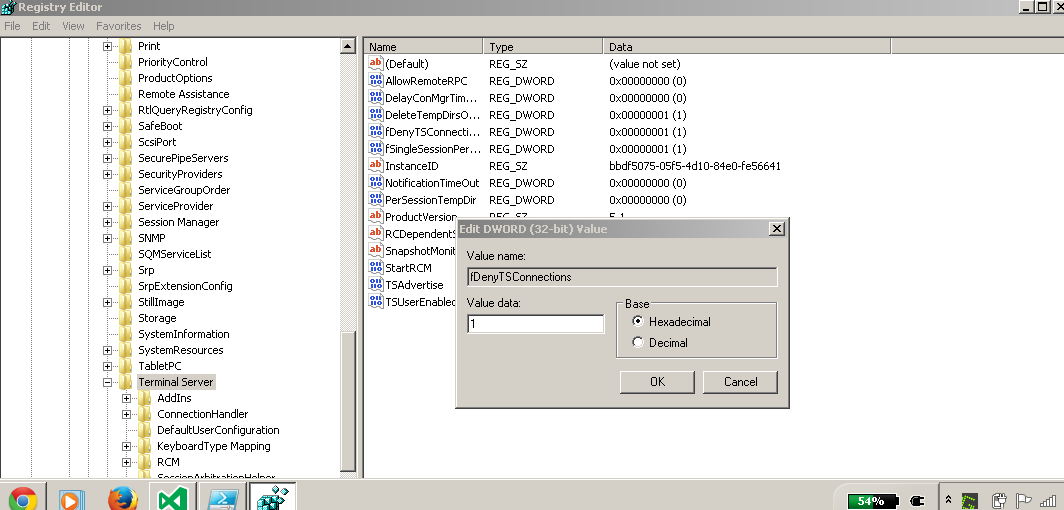As you know, the registry has DWORD, string, expand string, multi string, binary, and Qword value types. Let us take one by one. In all the examples I provide below, I will create/modify values under the HKLM Software Techibee key for the sake of demonstration. Hi, I am trying to recurse through a remote registry key path and search through it for a value name and get the value data.Hence i need to give it atleast a subkey to start from so as to avoid searching time delay through many nodes. We will how to write a value in the registry of a remote PC enable remoting. The Enable-PSRemoting cmdlet configures the computer to receive Windows PowerShell remote commands sent for differnet operations. Dismiss Join GitHub today. GitHub is home to over 50 million developers working together to host and review code, manage projects, and build software together.
FunctionGet-SqlServerKey{
<#
.SYNOPSIS
Gets SQL Server Product Keys from local on destination SQL Servers. Works with SQL Server 2005-2014
.DESCRIPTION
Using a string of servers, a text file, or Central Management Server to provide a list of servers, this script will go to each server and get the product key for all installed instances. Clustered instances are supported as well. Requires regular user access to the SQL instances, SMO installed locally, Remote Registry enabled and acessible by the account running the script.
Uses key decoder by Jakob Bindslet (http://goo.gl/1jiwcB)
.PARAMETER SqlServers
A comma separated list of servers. This can be the NetBIOS name, IP, or SQL instance name
.PARAMETER SqlCms
Compiles list of servers to inventory using all servers stored within a Central Management Server. Requires having SQL Management Studio installed.
.PARAMETER ServersFromFile
Uses a text file as input. The file must be formatted as such:
sqlserver1
sqlserver2
.PARAMETER SqlCredential
Allows you to login to servers using SQL Logins as opposed to Windows Auth/Integrated/Trusted. To use:
$cred = Get-Credential, this pass this $cred to the param.
Windows Authentication will be used if DestinationSqlCredential is not specified. To connect as a different Windows user, run PowerShell as that user.
.NOTES
Author: Chrissy LeMaire (@cl), netnerds.net
Requires: PowerShell Version 3.0, SQL Server SMO, Remote Registry
dbatools PowerShell module (https://dbatools.io, clemaire@gmail.com)
Copyright (C) 2016 Chrissy LeMaire
This program is free software: you can redistribute it and/or modify
it under the terms of the GNU General Public License as published by
the Free Software Foundation, either version 3 of the License, or
(at your option) any later version.
This program is distributed in the hope that it will be useful,
but WITHOUT ANY WARRANTY; without even the implied warranty of
MERCHANTABILITY or FITNESS FOR A PARTICULAR PURPOSE. See the
GNU General Public License for more details.
You should have received a copy of the GNU General Public License
along with this program. If not, see <http://www.gnu.org/licenses/>.
.LINK
https://dbatools.io/Get-SqlServerKey
.EXAMPLE
Get-SqlServerKey winxp, sqlservera, sqlserver2014a, win2k8
Gets SQL Server versions, editions and product keys for all instances within each server or workstation.
.EXAMPLE
Get-SqlServerKey -SqlCms sqlserver01
Gets SQL Server versions, editions and product keys for all instances within sqlserver01's Central Management Server
.EXAMPLE
Get-SqlServerKey -ServersFromFile C:Scriptsservers.txt
Gets SQL Server versions, editions and product keys for all instances listed within C:Scriptsservers.txt
#>
[CmdletBinding(DefaultParameterSetName='Default')]
Param(
[parameter(Position=0)]
[Alias('ServerInstance','SqlInstance')]
[string[]]$SqlServers,
# Central Management Server
[string]$SqlCms,
# File with one server per line
[string]$ServersFromFile,
[System.Management.Automation.PSCredential]$SqlCredential
)
BEGIN
{
FunctionUnlock-SqlServerKey
{
[CmdletBinding()]
param(
[Parameter(Mandatory=$true)]
[byte[]]$data,
[int]$version
)
try
{
if($version-ge11){$binArray=($data)[0..66]}
else{$binArray=($data)[52..66]}
$charsArray='B','C','D','F','G','H','J','K','M','P','Q','R',
 'T','V','W','X','Y','2','3','4','6','7','8','9'
'T','V','W','X','Y','2','3','4','6','7','8','9'for($i=24;$i-ge0;$i--)
{
$k=0
for($j=14;$j-ge0;$j--)
{
$k=$k*256-bxor$binArray[$j]
$binArray[$j]=[math]::truncate($k/24)
$k=$k%24
}
$productKey=$charsArray[$k]+$productKey
if(($i%5-eq0)-and($i-ne0))
{
$productKey='-'+$productKey
}
}
}
catch{$productkey='Cannot decode product key.'}
return$productKey
}
}
PROCESS
{
if($SqlCms)
{
if([Reflection.Assembly]::LoadWithPartialName('Microsoft.SqlServer.Management.RegisteredServers')-eq$null)
{throw'Can't load CMS assemblies. You must have SQL Server Management Studio installed to use the -SqlCms switch.'}
Write-Output'Gathering SQL Servers names from Central Management Server'
$server=Connect-SqlServer-SqlServer$SqlCms-SqlCredential$SqlCredential
$sqlconnection=$server.ConnectionContext.SqlConnectionObject
try{$cmstore=New-ObjectMicrosoft.SqlServer.Management.RegisteredServers.RegisteredServersStore($sqlconnection)}
catch{throw'Cannot access Central Management Server'}
$dbstore=$cmstore.DatabaseEngineServerGroup
$SqlServers=$dbstore.GetDescendantRegisteredServers().servername
# Add the CM server itself, which can't be stored in the CM server.
$servers+=$SqlCms
$basenames=@()
foreach($serverin$SqlServers){$basenames+=$server.Split(')[0]}
$SqlServers=$basenames|Get-Unique
}
If($ServersFromFile)
{
if((Test-Path$ServersFromFile)-eq$false){throw'Could not find file: $ServersFromFile'}
$SqlServers=Get-Content$ServersFromFile
}
if([string]::IsNullOrEmpty($SqlServers)){$SqlServers=$env:computername}
$basepath='SOFTWAREMicrosoftMicrosoft SQL Server'
# Loop through each server
$objectCollection=@()
foreach($servernamein$SqlServers)
{
$servername=$servername.Split(')[0]
if($servername-eq'.'-or$servername-eq'localhost'-or$servername-eq$env:computername)
{
$localmachine=[Microsoft.Win32.RegistryHive]::LocalMachine
$defaultview=[Microsoft.Win32.RegistryView]::Default
$reg=[Microsoft.Win32.RegistryKey]::OpenBaseKey($localmachine,$defaultview)
}
else
{
# Get IP for remote registry access. It's the most reliable.
try{$ipaddr=([System.Net.Dns]::GetHostAddresses($servername)).IPAddressToString}
catch{Write-Warning'Can't resolve $servername. Skipping.';continue}
try
{
$reg=[Microsoft.Win32.RegistryKey]::OpenRemoteBaseKey('LocalMachine',$ipaddr)
}
catch{Write-Warning'Can't access registry for $servername. Is the Remote Registry service started?';continue}
}
$instances=$reg.OpenSubKey('$basepathInstance NamesSQL',$false)
if($instances-eq$null){Write-Warning'No instances found on $servername. Skipping.';continue}
# Get Product Keys for all instances on the server.
foreach($instancein$instances.GetValueNames())
{
if($instance-eq'MSSQLSERVER'){$sqlserver=$servername}
else{$sqlserver='$servername$instance'}
$subkeys=$reg.OpenSubKey('$basepath',$false)
$instancekey=$subkeys.GetSubKeynames()|Where-Object{$_-like'*.$instance'}
if($instancekey-eq$null){$instancekey=$instance}# SQL 2k5
# Cluster instance hostnames are required for SMO connection
$cluster=$reg.OpenSubKey('$basepath$instancekeyCluster',$false)
if($cluster-ne$null)
{
$clustername=$cluster.GetValue('ClusterName')
if($instance-eq'MSSQLSERVER'){$sqlserver=$clustername}
else{$sqlserver='$clustername$instance'}
}
Write-Verbose'Attempting to connect to $sqlserver'
try{$server=Connect-SqlServer-SqlServer$SqlServer
Powershell Opensubkey
-SqlCredential$SqlCredential}catch{Write-Warning'Can't connect to $sqlserver or access denied. Skipping.';continue}
$servicePack=$server.ProductLevel
Write-Debug'$servername $instance version is $($server.VersionMajor)'
switch($server.VersionMajor)
{
9{
$sqlversion='SQL Server 2005 $servicePack'
$findkeys=$reg.OpenSubKey('$basepath90ProductID',$false)
foreach($findkeyin$findkeys.GetValueNames())
{
if($findkey-like'DigitalProductID*'){$key='$basepath90ProductID$findkey'}
}
}
10{
$sqlversion='SQL Server 2008 $servicePack'
$key='$basepathMSSQL10'
if($server.VersionMinor-eq50){$key+='_50';$sqlversion='SQL Server 2008 R2 $servicePack'}
$key+='.$instanceSetupDigitalProductID'
}
11{$key='$basepath110ToolsSetupDigitalProductID';$sqlversion='SQL Server 2012 $servicePack'}
12{$key='$basepath120ToolsSetupDigitalProductID';$sqlversion='SQL Server 2014 $servicePack'}
13{$key='$basepath130ToolsSetupDigitalProductID';$sqlversion='SQL Server 2016 $servicePack'}
default{Write-Warning'SQL version not currently supported.';continue}
}
if($server.Edition-notlike'*Express*')
{
try
{
C# Registrykey
$subkey=Split-Path$key;$binaryvalue=Split-Path$key-leaf
$binarykey=$($reg.OpenSubKey($subkey)).GetValue($binaryvalue)
}
catch{$sqlkey='Could not connect.'}
try{$sqlkey=Unlock-SqlServerKey$binarykey$server.VersionMajor}
catch{}
}
else{$sqlkey='SQL Server Express Edition'}
$server.ConnectionContext.Disconnect()
$object=New-ObjectPSObject-Property@{
'SQL Instance'=$sqlserver
'SQL Version'=$sqlversion
'SQL Edition'=$server.Edition
'Product Key'=$sqlkey
}
$objectCollection+=$object
}
$reg.Close()
}
$objectCollection|Select'SQL Instance','SQL Version','SQL Edition','Product Key'
}
Openremotebasekey Powershell
END{
# Write-Output 'Script completed'
Powershell Opensubkey Getvalue
}Registrykey Class
}